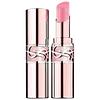What's inside
What's inside
 Key Ingredients
Key Ingredients

 Benefits
Benefits

 Concerns
Concerns

 Ingredients Side-by-side
Ingredients Side-by-side

Polyglyceryl-2 Triisostearate
EmulsifyingBis-Behenyl/Isostearyl/Phytosteryl Dimer Dilinoleyl Dimer Dilinoleate
EmollientSqualane
EmollientButyrospermum Parkii Butter
Skin ConditioningCellulose
AbsorbentDimer Dilinoleyl Dimer Dilinoleate
EmollientPolyglyceryl-3 Beeswax
EmulsifyingHelianthus Annuus Seed Cera
EmollientHydrogenated Castor Oil Dimer Dilinoleate
Skin ConditioningSimmondsia Chinensis Butter
Skin ConditioningHydrogenated Jojoba Oil
AbrasiveCandelilla Cera
EmollientPassiflora Edulis Seed Oil
EmollientCanola Oil
EmollientPentaerythrityl Tetra-Di-T-Butyl Hydroxyhydrocinnamate
AntioxidantCI 77499
Cosmetic ColorantCI 77492
Cosmetic ColorantCI 77891
Cosmetic ColorantCI 77491
Cosmetic ColorantCaprylic/Capric Triglyceride
MaskingPropylene Glycol
HumectantCitric Acid
BufferingCI 15850
Cosmetic ColorantCI 45380
Cosmetic ColorantTocopherol
AntioxidantAluminum Hydroxide
EmollientSilica
AbrasiveFicus Carica Fruit Extract
HumectantParfum
MaskingPolyglyceryl-2 Triisostearate, Bis-Behenyl/Isostearyl/Phytosteryl Dimer Dilinoleyl Dimer Dilinoleate, Squalane, Butyrospermum Parkii Butter, Cellulose, Dimer Dilinoleyl Dimer Dilinoleate, Polyglyceryl-3 Beeswax, Helianthus Annuus Seed Cera, Hydrogenated Castor Oil Dimer Dilinoleate, Simmondsia Chinensis Butter, Hydrogenated Jojoba Oil, Candelilla Cera, Passiflora Edulis Seed Oil, Canola Oil, Pentaerythrityl Tetra-Di-T-Butyl Hydroxyhydrocinnamate, CI 77499, CI 77492, CI 77891, CI 77491, Caprylic/Capric Triglyceride, Propylene Glycol, Citric Acid, CI 15850, CI 45380, Tocopherol, Aluminum Hydroxide, Silica, Ficus Carica Fruit Extract, Parfum
Diisostearyl Malate
EmollientBis-Behenyl/Isostearyl/Phytosteryl Dimer Dilinoleyl Dimer Dilinoleate
EmollientPentaerythrityl Adipate/Caprate/Caprylate/Heptanoate
EmollientVp/Hexadecene Copolymer
Paraffin
PerfumingOctyldodecanol
EmollientCera Microcristallina
Emulsion StabilisingCI 45410
Cosmetic ColorantSorbitan Sesquioleate
EmulsifyingSynthetic Wax
AbrasiveAlumina
AbrasiveDisteardimonium Hectorite
StabilisingCI 15985
Cosmetic ColorantTocopheryl Acetate
AntioxidantEthylene/Propylene Copolymer
AbrasivePropylene Carbonate
SolventParfum
MaskingDextrin Palmitate
EmulsifyingTocopherol
AntioxidantMangifera Indica Seed Oil
EmollientSodium Hyaluronate
HumectantCaprylic/Capric Triglyceride
MaskingWater
Skin Conditioning1,2-Hexanediol
Skin ConditioningMangifera Indica Fruit Extract
Skin ConditioningPunica Granatum Fruit Extract
AntioxidantDiisostearyl Malate, Bis-Behenyl/Isostearyl/Phytosteryl Dimer Dilinoleyl Dimer Dilinoleate, Pentaerythrityl Adipate/Caprate/Caprylate/Heptanoate, Vp/Hexadecene Copolymer, Paraffin, Octyldodecanol, Cera Microcristallina, CI 45410, Sorbitan Sesquioleate, Synthetic Wax, Alumina, Disteardimonium Hectorite, CI 15985, Tocopheryl Acetate, Ethylene/Propylene Copolymer, Propylene Carbonate, Parfum, Dextrin Palmitate, Tocopherol, Mangifera Indica Seed Oil, Sodium Hyaluronate, Caprylic/Capric Triglyceride, Water, 1,2-Hexanediol, Mangifera Indica Fruit Extract, Punica Granatum Fruit Extract
Ingredients Explained
These ingredients are found in both products.
Ingredients higher up in an ingredient list are typically present in a larger amount.
We don't have a description for Bis-Behenyl/Isostearyl/Phytosteryl Dimer Dilinoleyl Dimer Dilinoleate yet.
This ingredient is an emollient, solvent, and texture enhancer. It is considered a skin-softener by helping the skin prevent moisture loss.
It helps thicken a product's formula and makes it easier to spread by dissolving clumping compounds.
Caprylic Triglyceride is made by combining glycerin with coconut oil, forming a clear liquid.
While there is an assumption Caprylic Triglyceride can clog pores due to it being derived from coconut oil, there is no research supporting this.
Learn more about Caprylic/Capric TriglycerideParfum is a catch-all term for an ingredient or more that is used to give a scent to products.
Also called "fragrance", this ingredient can be a blend of hundreds of chemicals or plant oils. This means every product with "fragrance" or "parfum" in the ingredients list is a different mixture.
For instance, Habanolide is a proprietary trade name for a specific aroma chemical. When used as a fragrance ingredient in cosmetics, most aroma chemicals fall under the broad labeling category of “FRAGRANCE” or “PARFUM” according to EU and US regulations.
The term 'parfum' or 'fragrance' is not regulated in many countries. In many cases, it is up to the brand to define this term.
For instance, many brands choose to label themselves as "fragrance-free" because they are not using synthetic fragrances. However, their products may still contain ingredients such as essential oils that are considered a fragrance by INCI standards.
One example is Calendula flower extract. Calendula is an essential oil that still imparts a scent or 'fragrance'.
Depending on the blend, the ingredients in the mixture can cause allergies and sensitivities on the skin. Some ingredients that are known EU allergens include linalool and citronellol.
Parfum can also be used to mask or cover an unpleasant scent.
The bottom line is: not all fragrances/parfum/ingredients are created equally. If you are worried about fragrances, we recommend taking a closer look at an ingredient. And of course, we always recommend speaking with a professional.
Learn more about ParfumTocopherol (also known as Vitamin E) is a common antioxidant used to help protect the skin from free-radicals and strengthen the skin barrier. It's also fat soluble - this means our skin is great at absorbing it.
Vitamin E also helps keep your natural skin lipids healthy. Your lipid skin barrier naturally consists of lipids, ceramides, and fatty acids. Vitamin E offers extra protection for your skin’s lipid barrier, keeping your skin healthy and nourished.
Another benefit is a bit of UV protection. Vitamin E helps reduce the damage caused by UVB rays. (It should not replace your sunscreen). Combining it with Vitamin C can decrease sunburned cells and hyperpigmentation after UV exposure.
You might have noticed Vitamin E + C often paired together. This is because it is great at stabilizing Vitamin C. Using the two together helps increase the effectiveness of both ingredients.
There are often claims that Vitamin E can reduce/prevent scarring, but these claims haven't been confirmed by scientific research.
Learn more about Tocopherol